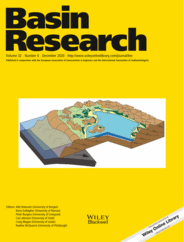
Full text loading...
 , Sébastien Carretier1
, Sébastien Carretier1 , Stéphane Bonnet1
, Stéphane Bonnet1
The influence of climate on mountain denudation has been the topic of an intense debate for two decades. This debate partly arises from the covariation of rainfall and topography during the growth of mountain ranges, both of which influence denudation. However, the denudational response of this co‐evolution is poorly understood. Here, we use a landscape evolution model where the rainfall evolves according to a prescribed rainfall–elevation relationship. This relationship is a bell curve defined by a rainfall base level, a rainfall maximum and a width around the rainfall peak elevation. This is a first‐order model that fits a large range of orographic rainfall data at the ca. 1‐km spatial scale. We carried out simulations of an uplifting block with an alluvial apron, starting from an initially horizontal surface, and testing different rainfall–elevation relationships. We find that the denudation history is different from that with constant rainfall models. The results essentially depend on the ratio between the final steady‐state summit elevation Hss and the prescribed rainfall peak elevation Hp. This ratio is hard to predict because it depends on the transient coupling of rainfall and elevation. We identified three types of results according to Hss/Hp. If Hss/Hp > 4 (Type I), the denudation rates peak when the summits reach values close to Hp. If Hss/Hp > 1.5 and < 4 (Type II), the denudation is strongly accelerated when the elevation of the summits approaches Hp, and then the denudation increases slowly towards the uplift rate. If Hss/Hp < 1.5 (Type III), the denudation evolution is similar to situations with constant and homogeneous rainfall. In the Type I and II experiments, the mountain top is subjected to aridification once the summits have passed through Hp. To adapt to this reduced rainfall, the slopes increase. This can lead to a paradoxical situation where the mountain relief increases faster, whereas the denudation increases more slowly. The development of orographic precipitation may thus favour the stability of the mean denudation rate in a rising mountain. Despite the model limitations, including a constant rainfall–elevation relationship, our study suggests that the “classical” exponential increase in the denudation rate predicted by constant rainfall models is not the common case. Instead, the common case involves pulses and acceleration of the denudation even in the absence of uplift or global climate variations.
,The development of a precipitation peak at some elevation within mountain catchments appears to be a crucial factor that controls the denudation and topographic evolutions of a mountain. If the precipitation peak is located at low or medium elevation when the mountain has reached a dynamic equilibrium, the model predicts that denudation has strongly accelerated (b) in the early times of the mountain uplift, or even passed by a maximum resulting in a pulse of sediment outflux to basins (a). If the precipitation rate does not have a maximum in the mountain, it can be deduced that the denudation has not evolved differently from cases where the precipitation rate is constant (c). These results can be used to re‐examine the interpretation of sediment flux variations in real cases based on the current distribution of precipitation rates with altitude in mountain ranges.

Article metrics loading...

Full text loading...
References


Data & Media loading...

